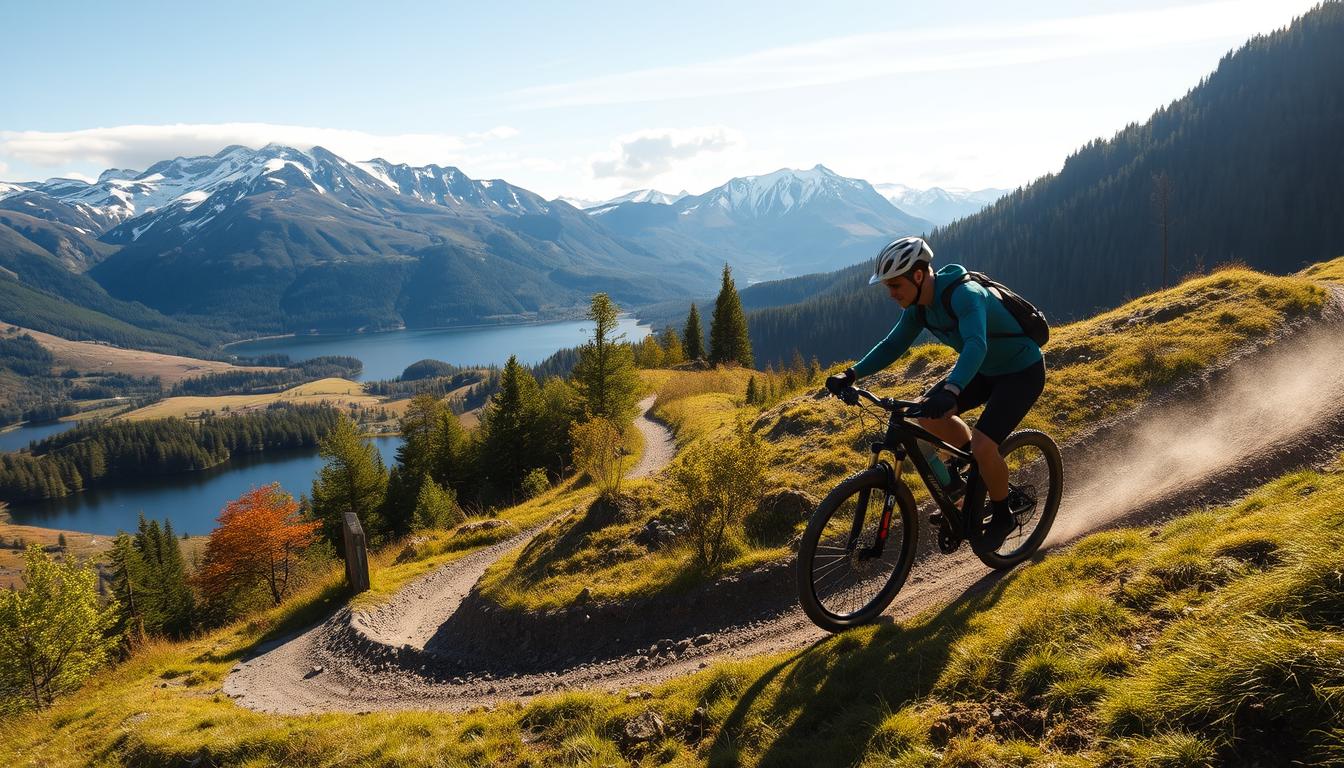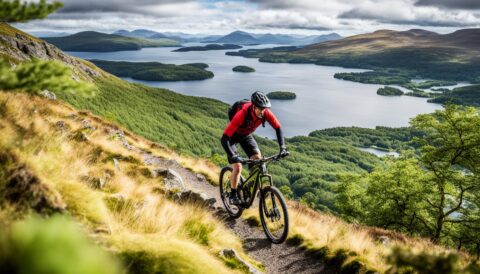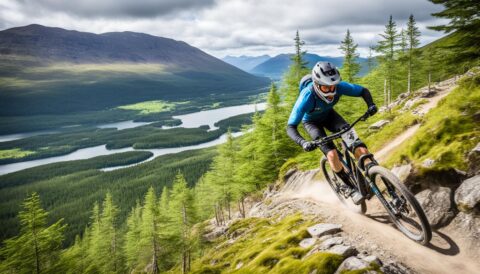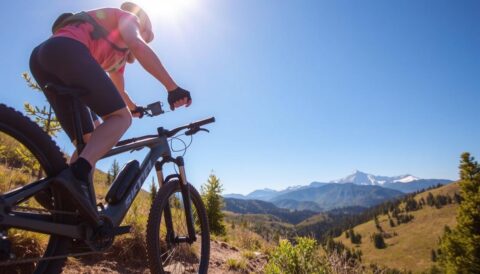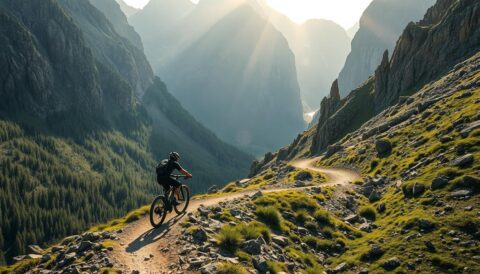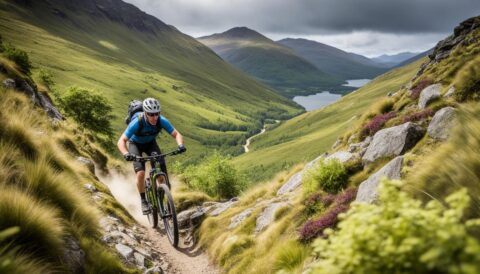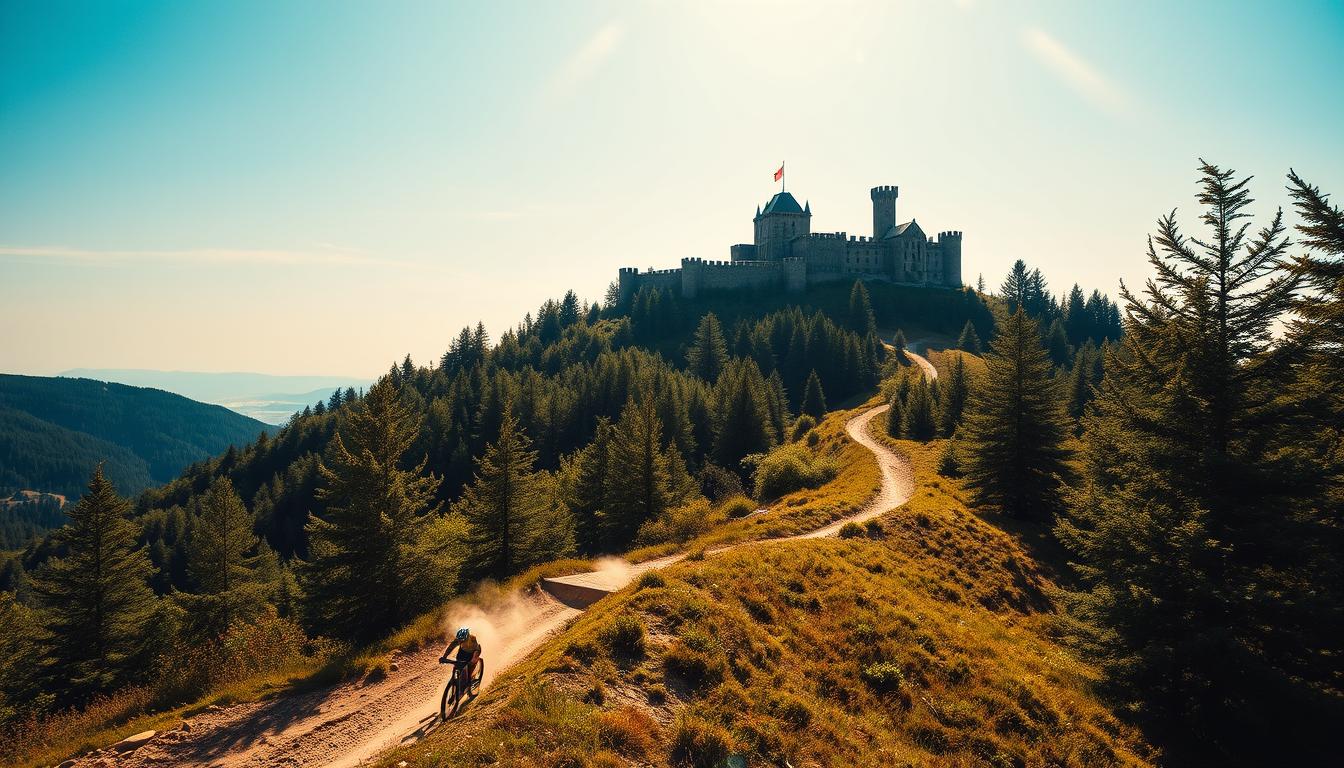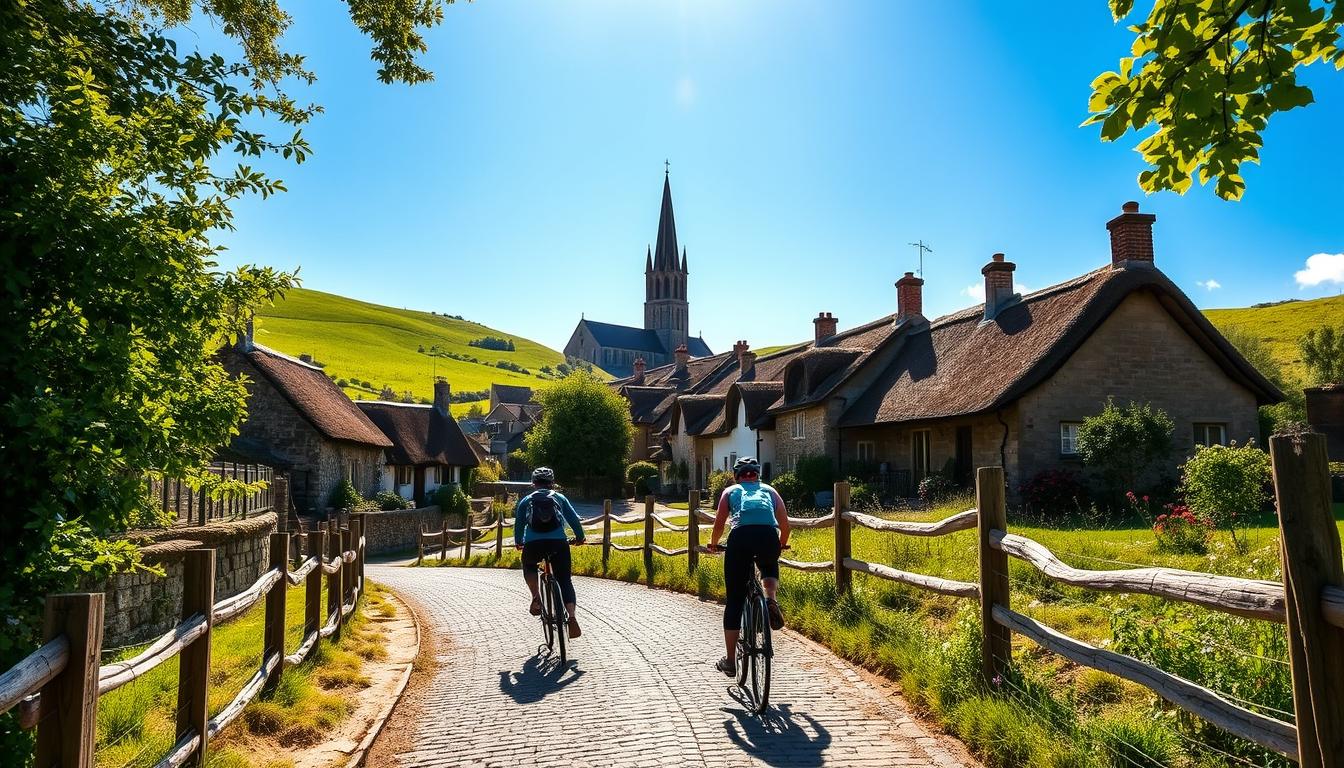Scotland’s premier long-distance route offers an unforgettable journey, blending urban starts with vast wilderness. This trail is a magnet for adventure seekers, combining challenging terrains with breathtaking landscapes. From the shores of Loch Lomond to the dramatic peaks of Glencoe, every mile tells a story.
Fort William, nestled at the foot of Ben Nevis, marks the end of this epic route. Intermediate riders will find it an achievable challenge with proper preparation. The trail’s unique charm lies in its honesty boxes and bothy culture, adding a touch of tradition to the experience.
First-hand accounts highlight the technical demands and stunning scenery. Whether you’re navigating rocky paths or soaking in panoramic views, this adventure promises to leave a lasting impression.
Key Takeaways
- Scotland’s premier long-distance route combines urban starts with wilderness.
- Key landmarks include Loch Lomond, Glencoe, and Ben Nevis.
- An achievable challenge for intermediate riders with proper preparation.
- Unique aspects like honesty boxes and bothy culture enhance the experience.
- First-hand accounts emphasise technical demands and scenic beauty.
Introduction to Mountain Biking the West Highland Way
Known for its rugged beauty, this route offers a unique blend of history and nature. The West Highland Way, Scotland’s first official long-distance trail, spans 96 miles from Milngavie to Fort William. It’s a magnet for adventurers, combining forest tracks, old military roads, and technical singletrack.
While many choose to walk the trail, cycling offers a distinct experience. Riders can cover ground faster, making it possible to complete the journey in as little as two days. For those seeking a more leisurely pace, it can take up to seven days, depending on fitness levels.
What is the West Highland Way?
Established in 1980, this iconic route attracts over 80,000 visitors annually. Its popularity among cyclists has grown steadily, thanks to its diverse terrains and breathtaking scenery. From the shores of Loch Lomond to the dramatic peaks of Glencoe, every mile tells a story.
Why Choose Mountain Biking?
Cycling allows you to tackle technical descents and enjoy the thrill of speed. It’s also a great way to immerse yourself in the landscape without spending weeks on the trail. As one police team noted, “The sense of achievement after completing the ride is unparalleled.”
Planning Your Adventure
Planning is key to ensuring a smooth and enjoyable experience on this legendary route. From choosing the right time to packing essential gear, every detail matters. Proper preparation allows you to focus on the stunning landscapes and challenges ahead.
Best Time to Go
Timing your trip can make a significant difference. Spring brings blooming wildflowers, while autumn offers vibrant colours. However, be mindful of midges, which are most active from May to September. A good repellent like Smidge is a must.
Weather conditions can vary, so pack layers to stay comfortable. If you’re looking for fewer crowds, late spring or early autumn are ideal. These periods also offer milder temperatures, making the ride more pleasant.
Essential Gear and Equipment
A reliable mountain bike is crucial. A full-suspension model under 14kg is recommended for tackling the varied terrain. Don’t forget a puncture repair kit, bike lock, and cash for honesty boxes along the way.
For convenience, consider using the AMS baggage transfer service, which costs £45. This allows you to travel lighter and focus on the ride. Always carry an emergency kit with foil blankets and extra food stores, especially if you plan to wild camp near Loch Lomond.
If you’re travelling by train, note that there’s a six-bike limit per service. Book your spot in advance to avoid disappointment. With the right gear and preparation, you’re set for an unforgettable adventure.
Getting to the Start: Milngavie
Milngavie, pronounced ‘Mill-guy’, is the gateway to an unforgettable adventure. This charming town, just north of Glasgow, is the official starting point for your journey. With its pedestrianised shopping precinct and welcoming atmosphere, it’s the perfect place to prepare for the ride ahead.
Transport Options
Reaching Milngavie is straightforward, with excellent transport links. Trains from Glasgow Queen Street run frequently, making it a convenient choice for cyclists. If you’re driving, secure parking solutions are available near the start point.
| Transport Type | Details |
|---|---|
| Train | Direct from Glasgow Queen Street, bike-friendly carriages |
| Car | Secure parking near the Premier Inn |
Pre-Ride Preparations
Before setting off, ensure your bikes are in top condition. Local shops offer final checks and repairs if needed. Stock up on last-minute supplies at the Tesco superstore, and consider staying at bike-friendly accommodation like the Premier Inn.
With everything in place, you’re ready to embark on your tour. Milngavie’s blend of convenience and charm ensures a smooth start to your day.
Route Overview
Spanning 96 miles, this route is a perfect blend of natural beauty and physical challenge. Whether you’re an experienced cyclist or a weekend adventurer, the journey offers something for everyone. From rolling hills to dramatic peaks, every part of the trail is packed with excitement.
Total Distance and Duration
The trail can be completed in 2 to 7 days, depending on your pace and fitness level. For those seeking a quick adventure, two days is achievable. However, a more leisurely pace allows you to soak in the stunning views and enjoy the journey.
| Duration | Daily Mileage | Elevation Profile |
|---|---|---|
| 2 Days | 48 miles/day | Challenging |
| 7 Days | 14 miles/day | Moderate |
Key Landmarks and Scenic Spots
Along the way, you’ll encounter iconic landmarks like Conic Hill and Buachaille Etive Mòr. These spots are perfect for capturing memorable photos. The trail also features wilderness sections, offering a true escape from civilisation.
One of the highlights is the Devil’s Staircase, a 260m ascent that tests your endurance. Near Inversnaid, a 55-mile detour is available for support vehicles. Viaduct crossings under railway lines add a unique charm to the journey.
When it comes to navigation, many cyclists debate between apps and paper maps. Both have their merits, so choose what works best for you. With so much to explore, this route is truly unforgettable.
Day 1: Milngavie to Drymen
The first day of your journey sets the tone for the adventure ahead. Starting from Milngavie, the route offers a gentle introduction with wide gravel paths. These are perfect for easing into the rhythm of the trail while enjoying the scenic countryside.
Terrain and Difficulty
The initial stretch is relatively flat, making it accessible for most riders. However, multiple gates along the way require careful navigation. The Gartness road section adds a bit of variety, with smooth tarmac replacing the gravel.
Blane Valley introduces a slight climb, and thorn hazards in this area mean you’ll need to stay alert. This part of the route serves as an initial fitness test before the more demanding sections near Loch Lomond.
Highlights and Challenges
One of the highlights is the singletrack near Drymen, offering a taste of technical riding. The village itself is a welcoming first stop, with cosy pubs like the Clachan Inn providing a perfect spot to refuel.
For those planning to wild camp, the area around Drymen offers serene spots. However, night riding requires extra caution due to uneven terrain and limited visibility.
- Gentle start on wide gravel paths.
- Multiple gates to navigate.
- Initial fitness test before Loch Lomond.
- Choose between village pubs or wild camping.
- Considerations for night riding.
Day 2: Drymen to Rowardennan
Day two brings a mix of challenging climbs and serene lakeside views. This leg of the journey is a favourite among adventurers, offering a blend of physical effort and natural beauty. From the ascent of Conic Hill to the tranquil shores of Loch Lomond, every moment is worth the effort.
Conic Hill Ascent
The climb up Conic Hill is a highlight of the day. With a 50% bike carry ratio, it’s a test of both strength and technique. Technical climb techniques like shifting your weight forward and maintaining a steady pace can make the ascent smoother.
Be prepared to share the path with walkers, especially during peak seasons. A friendly nod or quick chat can go a long way in fostering camaraderie on the trail.
Loch Lomond Views
As you descend, the shimmering waters of Loch Lomond come into view. This iconic landmark offers countless opportunities for photography, especially during sunset. “The colours reflecting off the water are simply magical,” says one seasoned rider.
For those seeking a refreshing break, lakeside wild swimming spots are scattered along the route. Just ensure you’re mindful of safety and local guidelines.
Reaching Rowardennan, the Rowardennan Hotel provides a welcoming end to the day. With comfortable rooms and hearty meals, it’s the perfect place to recharge. Whether you’re capturing the sunset or planning the next day’s ride, this stop is a memorable part of the journey.
Day 3: Rowardennan to Inverarnan
Day three introduces a mix of technical challenges and serene landscapes, making it a memorable part of the journey. This section of the route takes you along the upper shores of Loch Lomond, offering stunning views and a variety of terrains to navigate.
Upper Loch Lomond Section
The trail here is a blend of rocky paths and smooth road sections. One of the highlights is the “Type 2 fun” rock gardens, which test your bike-handling skills. These areas require careful navigation and, at times, bike carrying techniques to safely pass through.
For those looking for a unique experience, canoe portage options are available. This allows you to combine cycling with paddling, adding an extra layer of adventure to your trip.
Navigating the Tricky Terrain
The climb through this part of the trail can be demanding, especially with the rocky sections. However, the effort is rewarded with breathtaking views of the loch and surrounding hills. “The combination of challenge and beauty makes this day unforgettable,” says one seasoned rider.
River crossings are another feature of this bit. Always check the water levels and ensure your safety before attempting to cross. Midges can be a nuisance, so carry repellent and consider timing your ride to avoid peak activity.
- Use bike carrying techniques for rocky sections.
- Stay safe during river crossings by assessing conditions.
- Manage midges with repellent and strategic timing.
- Experience bothy culture for a unique overnight stay.
- Be prepared for night navigation challenges if needed.
As you approach Inverarnan, Beinglas Farm offers a warm welcome with its amenities. Whether you’re refuelling at the pub or resting in the campsite, it’s the perfect way to end the day. The combination of technical riding and serene landscapes ensures this leg of the journey is both challenging and rewarding.
Day 4: Inverarnan to Tyndrum
Day four brings a refreshing mix of scenic trails and cultural stops. This part of the journey is a favourite among riders, offering a blend of natural beauty and local traditions. From the flow trails of Glen Falloch to the charming honesty boxes, every moment is memorable.
Glen Falloch Trails
The Glen Falloch section is a highlight of the ride. Its flow trails are perfect for practising techniques like weight shifting and maintaining momentum. The 19th-century military roads add a historical touch, making the ride even more fascinating.
For those who love photography, the River Falloch offers stunning photo opportunities. Its crystal-clear waters and surrounding greenery create a picturesque backdrop. Don’t forget to capture these moments as you pass through.
Honesty Boxes and Local Stops
Honesty boxes are a unique feature of this route. These small stalls offer local produce like eggs, honey, and jams. It’s a great way to support local communities while enjoying fresh treats along the way.
When it comes to refuelling, the Real Food Cafe and Green Welly Stop are popular choices. Both offer hearty meals, but the Real Food Cafe is known for its cyclist-friendly atmosphere. In Crianlarich, you’ll find convenient resupply points for snacks and essentials.
| Stop | Highlights |
|---|---|
| Real Food Cafe | Cyclist-friendly, hearty meals |
| Green Welly Stop | Local produce, traditional vibe |
| Crianlarich | Resupply points, train connections |
As the day ends, Tyndrum offers a welcoming atmosphere. The local pubs are perfect for unwinding, but remember to follow evening pub etiquette. A friendly nod and a polite chat with locals can enhance your experience.
Day 5: Tyndrum to Kingshouse
Day five takes you through one of the most dramatic and remote sections of the trail. This leg of the journey is a test of endurance and a celebration of Scotland’s wild beauty. From the vast expanse of Rannoch Moor to the historic Old Military Road, every mile offers something unique.
Rannoch Moor Crossing
Crossing Rannoch Moor is an unforgettable experience. The moor’s stark, open landscape stretches as far as the eye can see, offering panoramic views that are both humbling and inspiring. Be prepared for exposure to the elements; wind and rain can make this section challenging.
Strategies for managing exposure include layering up and carrying waterproof gear. Weather shelter spots are few, so plan your stops carefully. At night, the moor transforms into a stargazer’s paradise, perfect for night sky photography. Keep an eye out for mountain hares, which are often spotted in this area.
Old Military Road
The Old Military Road is a testament to historic road engineering. Its cobbled surface has been preserved, adding a unique charm to the ride. While it can be rough in places, the road offers a smooth side to the otherwise rugged terrain.
For those seeking a detour, the Glencoe Ski Centre is a popular option. It’s a great place to refuel and take in the surrounding scenery. If you’re planning to stay overnight, bothy sleeping options are available, providing a rustic yet cosy experience.
| Feature | Details |
|---|---|
| Rannoch Moor | Panoramic views, exposure management, night sky photography |
| Old Military Road | Cobbled surface, historic engineering, Glencoe Ski Centre detour |
| Bothy Options | Rustic sleeping spots, unique overnight experience |
As you approach Kingshouse, take a moment to reflect on the day’s journey. The combination of stark landscapes and historic pathways makes this tour truly unforgettable. Whether you’re capturing the sunset or planning the next day’s ride, this stop is a memorable part of the adventure.
Day 6: Kingshouse to Kinlochleven
Day six brings a thrilling mix of steep climbs and rewarding descents. This section of the route is renowned for its challenging terrain and stunning views, making it a highlight for many riders. From the iconic Devil’s Staircase to the serene descent into Kinlochleven, every moment is packed with adventure.
Devil’s Staircase Challenge
The Devil’s Staircase is a legendary part of the trail, offering a 300m elevation change that tests both stamina and technique. This steep climb requires careful planning and switchback riding skills. “It’s a true test of endurance, but the views at the top are worth every pedal stroke,” says one experienced cyclist.
For those seeking an alternative, the Ciaran Path provides a less demanding route. However, the Devil’s Staircase remains a must-try for its sense of achievement and panoramic vistas. Knee protection is highly recommended, as the descent can be equally taxing on the joints.
Descending into Kinlochleven
After conquering the devil staircase, the ride into Kinlochleven is a rewarding experience. The descent offers a mix of technical sections and smooth trails, with the village’s aluminium smelter history adding a unique cultural touch. “The blend of natural beauty and industrial heritage makes this stop unforgettable,” notes a local guide.
Once in Kinlochleven, celebrate your achievement with a visit to the local pub. For the adventurous, white water rafting options are available nearby. Midge avoidance tactics are essential, especially during the summer months, so carry repellent and plan your timing wisely.
- Master switchback techniques for the Devil’s Staircase.
- Use knee protection during steep descents.
- Enjoy post-ride celebrations at Kinlochleven’s pubs.
- Explore white water rafting for an extra thrill.
- Stay prepared for midges with repellent and timing.
Day 7: Kinlochleven to Fort William
The final stretch of your journey brings a mix of triumph and reflection as you approach Fort William. This last leg of the trail is a celebration of your efforts, offering stunning views and a rewarding finish. From the ascent out of Kinlochleven to the descent into Fort William, every mile is packed with memories.
Final Climb and Descent
The day begins with a challenging climb out of Kinlochleven, testing your stamina one last time. As you ascend, the views of Loch Leven and the surrounding hills provide a perfect backdrop. The descent towards Fort William is equally thrilling, with smooth road sections and technical bits to keep you engaged.
For those seeking a unique experience, the Nevis Range gondola offers a scenic alternative. It’s a great way to take in the panoramic views without the physical strain. “The gondola ride was the perfect way to end the journey,” says one rider.
Arriving at Ben Nevis
As you reach Fort William, the towering presence of Ben Nevis marks the end of your adventure. The official WHW terminus stone is a popular spot for photos, serving as a tangible reminder of your achievement. Many riders celebrate with a visit to the Premier Inn, where bike wash facilities and a warm welcome await.
- Capture the moment at the terminus stone for a lasting memory.
- Time your arrival to ensure smooth train connections for your return journey.
- Consider a distillery tour to toast your success with a local whisky.
- Collect your completion certificate as a memento of your achievement.
Whether you’re reflecting on the journey or planning your next adventure, Fort William offers the perfect conclusion to this epic ride.
Challenges of Mountain Biking the West Highland Way
Embarking on this iconic trail presents unique challenges that test both skill and preparation. From unpredictable weather to persistent midges, riders must be ready for anything. Proper planning ensures these obstacles don’t overshadow the adventure.
Weather Conditions
The trail’s microclimates can shift dramatically within hours. One moment, you’re basking in sunshine; the next, you’re battling rain or wind. Over the years, riders have faced everything from sudden downpours to historic snowfalls.
Waterproofing your gear is essential. Layering up helps manage temperature changes, while quick-drying clothing ensures comfort. In emergencies, bothy drying techniques can save the day. Always carry a foil blanket and know the emergency bothy codes for safety.
Midges and Other Pests
Midges are a notorious challenge, especially during summer days. These tiny pests can turn a scenic ride into an itchy ordeal. Smidge repellent is highly effective, but timing your ride to avoid peak activity is equally important.
Ticks are another concern, particularly in wooded areas. Learn proper tick removal procedures to minimise risks. Carrying a first-aid kit and knowing emergency contact protocols ensures you’re prepared for any situation.
- Be ready for microclimate variations with adaptable gear.
- Invest in waterproofing solutions for sudden rain.
- Use Smidge repellent and plan your time to avoid midges.
- Stay vigilant for ticks and know how to remove them safely.
- Familiarise yourself with emergency codes and protocols.
Accommodation and Rest Stops
Finding the perfect place to rest after a long day’s ride can make all the difference. Whether you prefer wild camping under the stars or cosy B&Bs with hot showers, the trail offers options for every traveller. Smart planning ensures you wake up refreshed and ready for the next leg of your tour.
Wild Camping Tips
For those who love the great outdoors, wild camping is an unforgettable experience. Follow Leave No Trace principles to minimise your impact on the environment. Pack out all waste and avoid disturbing wildlife.
Bothy stays offer shelter in remote areas, but remember to follow etiquette. Keep noise levels low and leave firewood for the next visitors. The AMS locker system provides secure storage for valuables if you’re stopping in busier areas.
Recommended B&Bs and Hotels
If you fancy a more comfortable end to your days, consider these top picks:
- Hobbit Huts at Glencoe – Quirky woodland pods with stunning mountain views
- Kingshouse Hotel – Recently refurbished with a cyclist-friendly drying room
- Premier Inn Fort William – Budget-friendly with excellent bike storage
For a luxury splurge, the Inverlochy Castle Hotel offers five-star treatment. Booking windows vary, so reserve early during peak seasons. Many places fill up months in advance, especially along the popular side of Loch Lomond.
After a day by the sea of clouds on Rannoch Moor, a warm bed and hot meal become priceless comforts. Whether you choose rustic charm or hotel luxury, proper rest ensures you make the most of your adventure.
Safety and Trail Etiquette
Safety and courtesy go hand-in-hand when exploring shared paths. Whether you’re covering long distances or enjoying a short ride, understanding the rules of the trail ensures everyone has an enjoyable experience. This section covers essential protocols for sharing spaces and handling emergencies.
Sharing Paths with Others
The route sees many walkers, especially during peak seasons. Cyclists should yield to pedestrians and announce their approach clearly. A bell works better than voice alerts in windy conditions.
- Give way to uphill travellers when on narrow sections
- Slow down when passing large groups or animals
- Stay on marked paths to protect surrounding vegetation
On mixed-use road sections, ride single file and wear high-visibility clothing. Local rangers recommend dismounting in particularly crowded areas like Conic Hill during summer months.
Being Prepared for Emergencies
Remote sections require careful planning. Always carry:
- 1:5,000 scale OS maps (digital or paper)
- Fully charged mobile with emergency contacts saved
- Basic first aid supplies and bothy emergency kit
River crossings demand particular caution. Check water levels beforehand and unclip from pedals when navigating slippery rocks. If you must call Mountain Rescue (999 then ask for police), provide your exact grid reference and nature of injury.
Hypothermia risks exist even in summer. Pack spare layers and know the early warning signs – slurred speech and clumsy movements mean it’s time to seek shelter immediately. Bothies often stock emergency supplies, but never rely solely on these being available.
Alternative Routes and Add-Ons
For those seeking variety, the trail offers exciting detours and additional adventures. These alternatives provide fresh perspectives and unique challenges, enriching your overall experience.
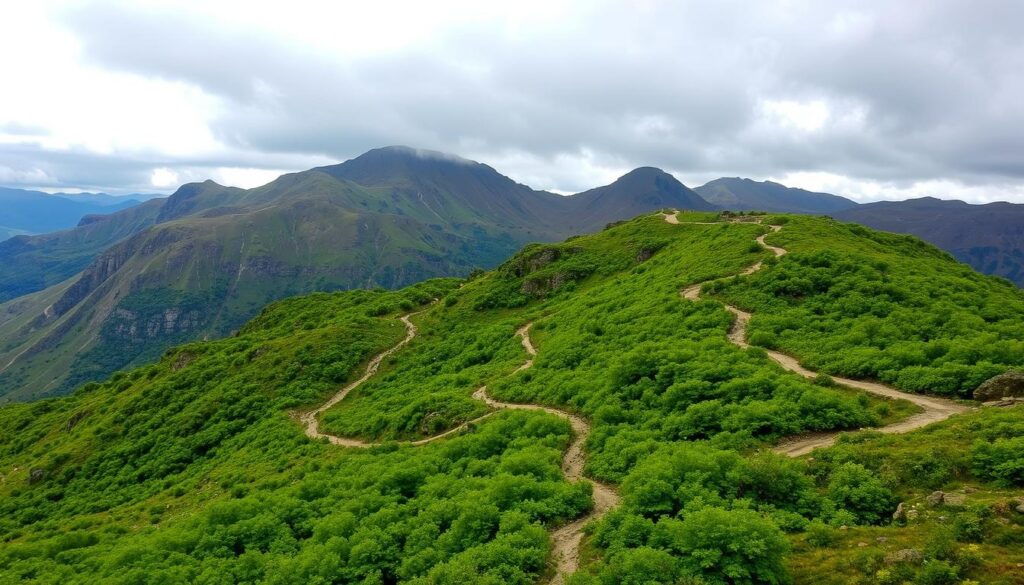
Ben Lomond and Glencoe Ski Centre
Ben Lomond is a popular detour, offering breathtaking views and a rewarding descent. With an average descent time of 45 minutes, it’s a thrilling addition to your journey. The Glencoe Ski Centre is another highlight, featuring blue trails perfect for intermediate riders. Uplift services are available, making it easier to explore the area.
For those interested in downhill biking, hire options are readily accessible. Guided walks and Via Ferrata routes add extra layers of adventure. The Coire Gabhail detour is a must for history enthusiasts, showcasing Scotland’s dramatic landscapes.
Exploring Glen Nevis
Glen Nevis is a haven for outdoor enthusiasts. The Nevis Range offers blue trails that cater to various skill levels. The Ciaran Path is a technical route, ideal for experienced riders seeking a challenge.
For a unique experience, consider the uplift service, which costs around £15 per ride. Guided walk options are also available, providing insights into the area’s rich history and natural beauty. Whether you’re tackling technical trails or enjoying a leisurely walk, Glen Nevis has something for everyone.
- Uplift service costs: £15 per ride
- Downhill bike hire: Available at Glencoe Ski Centre
- Guided walk options: Explore Glen Nevis with local experts
- Via Ferrata additions: Add an extra thrill to your adventure
- Coire Gabhail detour: Discover Scotland’s dramatic landscapes
Conclusion: Why Mountain Biking the West Highland Way is Unforgettable
Completing this iconic route leaves riders with a profound sense of accomplishment and lasting memories. The journey is more than just a physical challenge; it’s a testament to perseverance and personal growth. From rolling hills to rugged paths, the diverse landscapes make every mile unforgettable.
Along the way, the sense of community is palpable. Fellow adventurers and locals alike share stories and encouragement, creating bonds that last for years. Many riders find themselves planning a return trip, eager to experience the route’s ever-changing beauty in new seasons.
For those seeking an adventure that combines physical challenge with natural splendour, this trail is a must. It’s not just a ride—it’s a bucket-list experience that stays with you long after the journey ends.
FAQ
What is the West Highland Way?
The West Highland Way is a long-distance trail in Scotland, stretching 96 miles from Milngavie to Fort William. It’s famous for its stunning landscapes, including lochs, moors, and mountains.
Why choose mountain biking for this route?
Mountain biking offers a thrilling way to experience the trail, allowing you to cover more ground while enjoying the rugged terrain and breathtaking views.
When is the best time to go?
Late spring to early autumn (May to September) is ideal, with milder weather and longer daylight hours. However, always check forecasts as conditions can change quickly.
What gear is essential for the trip?
A reliable mountain bike, repair kit, waterproof clothing, and a good map or GPS are must-haves. Don’t forget essentials like water, snacks, and a first aid kit.
How do I get to the start in Milngavie?
Milngavie is easily accessible by train or car from Glasgow. Plan your journey in advance to ensure a smooth start to your adventure.
How long does it take to complete the route?
Most riders complete the trail in 5 to 7 days, depending on fitness levels and how much time you want to spend exploring.
What are the key landmarks along the way?
Highlights include Loch Lomond, Conic Hill, Rannoch Moor, the Devil’s Staircase, and the finish at Ben Nevis.
What’s the terrain like on Day 1?
The first section from Milngavie to Drymen is relatively gentle, with a mix of paths and tracks, making it a good warm-up for the days ahead.
What’s special about the Conic Hill ascent?
Conic Hill offers panoramic views of Loch Lomond and the surrounding area, making it a rewarding climb despite its steep sections.
How challenging is the Devil’s Staircase?
The Devil’s Staircase is a steep climb but is manageable with proper preparation. The descent into Kinlochleven is equally thrilling.
What should I know about sharing the trail with walkers?
Always be courteous, give way to walkers, and announce your presence when approaching from behind. Respecting others ensures a pleasant experience for everyone.
Are there wild camping options?
Yes, wild camping is allowed in most areas, but follow the Scottish Outdoor Access Code and leave no trace of your stay.
What are the weather conditions like?
Weather can be unpredictable, with rain, wind, and even sunshine all possible in one day. Pack layers and waterproofs to stay prepared.
Are there alternative routes to explore?
Yes, you can add detours to Ben Lomond or Glencoe Ski Centre for extra adventure and stunning scenery.
Why is this trip unforgettable?
The combination of challenging terrain, stunning landscapes, and the sense of achievement makes mountain biking the West Highland Way a truly memorable experience.
